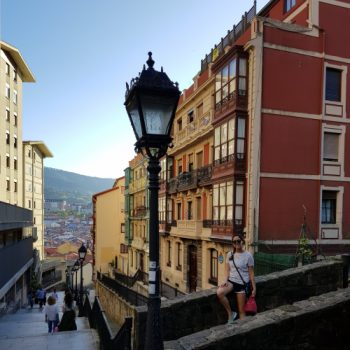
What You Need to Know About the DELE Exam
Dear Anna,
When you are on your journey to language learning, there will be times when you want to test how well you are doing and/or have proof that you have learned a certain amount of Spanish. You may also need a certification to show a potential boss or educational system that you are, in fact, ready to take on tasks in your new language. Whatever the reason, if you want to have a validated assessment of your Spanish skills, we highly recommend the DELE exam.
 What is the DELE exam
What is the DELE exam
DELE stands for Diploma de Español como Lengua Extranjera (Spanish as a Foreign Language Certification) and is the official Spanish—as in, from Spain, not necessarily the only Spanish language one—certification that is carried out by Instituto Cervantes and granted by the Spanish Ministry of Education, Culture and Sport. This exam is widely recognized as a way to certify the level of your Spanish skills. The certification does not expire, so, once you have it, you can use it throughout your life.
Before we continue, we would like to note that although we don’t believe you need an exam to prove your Spanish skills, we highly recommend this exam if you are looking for a Certification as it is one of the most recognized worldwide. If you decide this is the path for you, this article will share with you what you should know about the exam.
What you should know about the DELE exam
Like most language exams, the DELE is made up of different sections and each section is allocated a certain number of questions. In addition, each section corresponds to a certain number of points and, to pass the exams, you have to achieve a minimum number of points.
The Levels of the DELE exam
The different levels of proficiency you will find in the DELE exam correspond to the Common European Framework of Reference for Languages: Learning, Teaching, Assessment (CEFR). You can read more about this Framework on this page but what this essentially means is that the levels of the DELE exam are determined using the same model as 40 other different languages found around the world. Why does this bring value, you might ask? Well, by creating universally recognized levels, language learners, teachers, universities, employers, etc. are able to compare the skills of the learner. The downside of this is that we do not believe that these exams are foolproof nor do we believe that they always tell the whole story of someone’s language experience. However, they do provide a solid framework within which quick comparisons can be made, which is useful in today’s world.
 According to the CEFR, there are three main levels of language learning, each broken down into two further levels:
According to the CEFR, there are three main levels of language learning, each broken down into two further levels:
If you are at an “A” level, you are a basic user. A “B” level corresponds to an independent user. And if you have a “C” level, that means you are a proficient user. Now, let’s see what that looks like when we break it down a bit more:
A1 is the level they call “Breakthrough.” Practically speaking, this means the language user has the most basic identifiable proficiency of Spanish. To measure these skills, test takers are given isolated tasks and asked to complete them. The tasks usually correspond to concrete learning objectives that new language users will want to complete, such as immediate needs or language used in everyday situations.
A2 is the level they call “Waystage.” Language users arrive at this stage when they are able to use Spanish in simple everyday interactions. Most people at this level will be able to communicate in a way that allows them to share and understand basic information about themselves, their families, their work, etc. At a higher A2 level, language users are slowly able to have a more active participation in everyday life. This is the level required to obtain Spanish citizenship.
B1 is the level they call “Threshold.” The difference between this and the previous level is that language users at the B1 level will be able to follow more interactions and discussions and participate in them. This level, however, is still quite basic, so consider the interactions within the scope of a basic language learner who is able to communicate problems, experiences, wishes, etc. at a beginner’s level.
 B2 is the level they call “Vantage.” In comparison to the previous levels, B2 represents a much higher capacity to communicate and interact with society. Most universities recommend at least a B2 Certification to take your degree or Master’s in Spain (and may require this or a lower level). This exam will expect you to be able to interact with native speakers around a variety of subjects as well as begin to recognize your own mistakes and be able to correct yourself.
B2 is the level they call “Vantage.” In comparison to the previous levels, B2 represents a much higher capacity to communicate and interact with society. Most universities recommend at least a B2 Certification to take your degree or Master’s in Spain (and may require this or a lower level). This exam will expect you to be able to interact with native speakers around a variety of subjects as well as begin to recognize your own mistakes and be able to correct yourself.
C1 is the level they call “Efficient Operational Proficiency.” All of the characteristics of someone who commands a B2 level of Spanish will apply to the C1, the main difference here is that the language user is able to communicate in Spanish in a fluent, spontaneous way. Of course, this doesn’t mean that the language user doesn’t make mistakes but that he or she is able to talk about a broad range of topics whenever they appear. In addition, the language user should be able to write clear texts and understand complicated discourse.
C2 is the level they call “Mastery.” This is the highest level of certification that is within the CEFR. Oftentimes it is colloquially referred to as native-level language skills but, in fact, is more related to the precision and ease that these high level users possess. Language users with a C2 will be able to communicate effectively in any situation.
Note: Claudia’s brother holds a C2 DELE certification and, while studying for the exam, found that many of his native-speaking Spanish friends had difficulty with the preparation questions for the exam.
Of course, many language learners, teachers, and schools of thought will break these learning phases down even more. However, if you are going to take the DELE exam, you will have to choose one of the six to study for. While we believe that you should probably be working with a teacher or a school to determine your level of Spanish, if you take this quiz (in Spanish), you will be able to get a general overview of where your language level is. You can also check out this grid (in Spanish) that breaks down each section of the exam (more below) and shares with you the skills you need to know for each of the different levels. For a very in-depth view, you can check out this page (in Spanish) for what you should know in different areas of language learning.
In addition, we would like to note that you do not need to complete each level to move onto the next one but, instead, should aim to take the highest level that you feel comfortable with. We would recommend only starting with the official DELE exams after level B1 (or even B2) because they are quite expensive and a lower level than B1 in Spanish will only be recognized and useful in very specific situations.
The Sections of the DELE exam
The different sections that correspond to the level of exam you are taking. Levels A1 through B2 are divided the same way:
-
Reading (Comprensión de lectura): 25 points
-
Writing (Expresión e interacción escritas): 25 points
-
Listening (Comprensión auditiva): 25 points
-
Speaking (Expresión e interacción orales): 25 points
For levels A1 to B2, when you are completing these different sections, you have to get at least 30 points from the Reading and Writing sections together (total available points: 50) and at least 30 points from the Listening and Speaking sections together (total available points: 50). This means that you do have some flexibility on how you are scored and, even if you do very poorly in one section, you can compensate by doing well in another section. However, for each of the exams A1 to B2, you will find that the timing and the number of questions you will have to complete is different. We recommend checking out this page (in Spanish) to get a better overview of the breakdown of the sections
 For level C1 of the exam, there are also four sections:
For level C1 of the exam, there are also four sections:
-
Reading and Language Use (Comprensión de lectura y uso de la lengua): 25 points
-
Listening and Writing (Destrezas integradas: comprensión auditiva y expresión e interacción escritas): 25 points
-
Listening and Language Use (Comprensión auditiva y uso de la lengua): 25 points
-
Reading and Speaking (Destrezas integradas: comprensión de lectura y expresión e interacción orales): 25 points
Level C1 works in a similar way to levels A1 to B2. You have to get at least 30 points from the Reading and Language Use together with the Listening and Writing section (total available points: 50) and at least 30 points from the Listening and Language Use together with the Reading Speaking section (total available points: 50). Again, this gives you some flexibility to compensate sections that were more difficult with sections that are easier.
For level C2, the format of the exam changes and there are only three parts, each worth 33.33 points, of which you must achieve 20 points per section. The three sections are:
-
Language Use (Destrezas integradas: uso de la lengua, comprensión de lectura y auditiva): 33.33 points
-
Writing (Destrezas integradas: comprensión auditiva y de lectura y expresión e interacción escritas): 33.33 points
-
Speaking (Destrezas integradas: comprensión de lectura y expresión e interacción orales): 33.33 points
Again, you can check out this page (in Spanish) to get a broader overview of the timing and the number of questions that correspond to each section.
When You Can Take the DELE Exam
The DELE is organized several times a year in more than 1,000 different centers in over 100 countries. The potential dates to take the exams are standardized by the Instituto Cervantes and each center can decide which dates they want to offer. Therefore, you will have to check directly with a center near you to see if there is a date that fits what you are looking for. On this page (in Spanish) you will be able to check the country, regions, and centers when and where the exam is offered.
The general calendar is usually quite similar every year, although the days can change. For 2020 it is:
-
February: Written exam February 14th (sign-up deadline January 8th) > Levels offered A2
-
April: Canceled (an additional exam has been scheduled for July)
-
May: Canceled (an additional exam has been scheduled for October)
-
July: Written exam July 10th (sign-up deadline June 17th) > Levels offered A1, A2, B1, B2, C1
-
Extra Exam July: Written exam July 31st (sign-up deadline July 8th) > Levels offered A2
-
September: Written exam September 11th (sign-up deadline August 19th) > Levels offered A1, A2, B1, B2, C1, C2
-

An example of what you might see of dates and prices from your exam center. Screenshot from https://castila.es/ October: Written exam October 2nd (sign-up deadline September 9th) > Levels offered A2, B1, B2, C1
-
Extra Exam October: Written exam October 23rd (sign-up deadline September 30th) > Levels offered A2, B1, B2
-
November: Written exam November 13th and 14th (sign-up deadline October 14th) > Levels offered A1, A2, B1, B2, C1, C2
You can see more about when (cuándo) you can take your exams here (in Spanish). Please note, however, that the availability of each exam will depend on the center where you plan to take it. In addition, make sure to sign up early as each center has a limited number of places and they can fill up.
The Cost of Taking the DELE Exam
The price that you will pay for the exam will depend on the level that you sign up for and where you decide to take it. Not only will the country in which you decide to take it in influence the price, but the center where you choose to take the exam can also impact the price. The general cost will go up the higher the level that you decide to take, which makes sense as each exam has different elements, some that have to be corrected manually and these tasks get more complicated as the level increases. While you should check with the individual center you plan to take the exam for exact prices, generally speaking, you can expect to pay the following prices for the different levels of the exam:
-
A1: 108€
-
A2: 130€
-
B1: 160€
-
B2: 190€
-
C1: 205€
-
C2: 220€
How to Register for the DELE exam
 Registering for the DELE exam can feel a bit complicated because you will have to sign up on the Instituto Cervantes page which is all in Spanish (they are taking their task as helping non-native speakers learn seriously!). You can sign up in two main ways:
Registering for the DELE exam can feel a bit complicated because you will have to sign up on the Instituto Cervantes page which is all in Spanish (they are taking their task as helping non-native speakers learn seriously!). You can sign up in two main ways:
-
Online, using the portal available to you if you will be taking the exam in Spain
-
In each examination center if you will be taking the exam outside of Spain
As we are based in Spain, we will focus on the online sign-up. You will have to follow these steps:
Create a new account: Using this webpage (in Spanish), you will have to create a new user account where you add in information like your email address, first and last name, ID information, title, gender, birthday, place of birth, nationality, and native language. You will also have to tick the checkboxes that you are of age or have your parents permission to access this website and that you have read and accept the legal warning and privacy policy of the page.
Confirm your email address: If everything works as it should, once you have created your user account, you will receive a confirmation email titled “Exámenes. Bienvenida del Instituto Cervantes” (Exams. Welcome to the Instituto Cervantes) and should click on the first link to confirm your email address.
Create a password: When you open this link you should then click on “Iniciar sesión” or “Start Session” and you will be asked to set up a password. We recommend you choose a password that you will remember or write it down as it is how you will be able to access your information in the future.
Note: This is a link that you can only use once and will expire after 24 hours.
 Sign up for an exam: Once you have set your password, you will be taken to a page with “Mis inscripciones” or the link that shows you the exams that you have signed up for. If you click on “Nueva inscripción,” you will be able to select the place you want to take the exam. If you already know the exam center where you want to take the exam, you can search specifically for that center. If you do not have a specific exam center you are planning to take the exam at, you can check the availability of different exams in the province where you would like to take the exam.
Sign up for an exam: Once you have set your password, you will be taken to a page with “Mis inscripciones” or the link that shows you the exams that you have signed up for. If you click on “Nueva inscripción,” you will be able to select the place you want to take the exam. If you already know the exam center where you want to take the exam, you can search specifically for that center. If you do not have a specific exam center you are planning to take the exam at, you can check the availability of different exams in the province where you would like to take the exam.
Once you have decided the exam and the location you would like to take, you can select “Inscribirse” and follow the next steps to ensure that you have entered all of your information in properly. You will have to pay the fee to your selected center, so you should contact them before the exam itself to ensure the process is carried out correctly.
Once you have registered for the exam, you should see it in “Mis inscripciones” under “Mi perfil” on your Instituto Cervantes page.
How to Prepare for the DELE exam
First of all, we want you to know that preparing for an exam is not the same as learning a language. Sure, there are elements in common and if your language knowledge is good enough, you should be able to pass a lower level the exam (C1 and C2, you will still probably want to review, no matter your language level). However, you should keep in mind that the exam will test all of your communication skills and, therefore, you will probably have to brush up on some of what you know before you are ready to pass with flying colors.
 True story: When Claudia went to study abroad in Portugal, she already could communicate verbally in Portuguese at a relatively fluent level, so much so that her examiner thought she was Brazilian. However, when she took the language exam, she only scored at a B2 level because her reading comprehension and writing were far below her speaking and listening skills. This is just one way that learning, communicating, and even thriving in a language is different to passing an exam.
True story: When Claudia went to study abroad in Portugal, she already could communicate verbally in Portuguese at a relatively fluent level, so much so that her examiner thought she was Brazilian. However, when she took the language exam, she only scored at a B2 level because her reading comprehension and writing were far below her speaking and listening skills. This is just one way that learning, communicating, and even thriving in a language is different to passing an exam.
Therefore, what do we think you should know about this exam? Well, first and foremost, we think you should take time to really understand the different sections and the amount of time you have for each section. Unlike in real life situations, this is a timed test and you will only be given so much time to complete a set number of tasks. In addition, this is a standardized test so the instructors will not be able to give you “just one more minute to figure out the last question.” That is why our first tip is to make sure you understand the format. In case you have just skipped to this section, check out how each of the different exams is distributed on this page (in Spanish).
You may decide, after having been exposed to Spanish over a period of time, that you want to tackle the pre-exam studying on your own. Of course, we understand that self-study and practicing isn’t always easy (trust us, we have been there). That is why in addition to the exam focused work you will do, we would encourage you to make it fun! Whether you are using Duolingo, a great game to get your head into everyday mindset of using the language, or if you prefer to watch tv series or movies, read books, or just make an extra effort to practice with friends, try to get a little extra language use into your everyday life.
If you are looking to work with a language teacher, you are probably looking at group classes or individual classes. In addition, you are probably wondering if you should be taking general Spanish classes or classes that are focused on passing the exam. Finally, you are probably seeing both intensive options (such as 4+ hours a day, 5 days a week of Spanish) or less intensive options (such as 2-3 hours a week). We think that whatever option you choose should fit your needs and your schedule. All of the combinations of classes are great, for different results. Therefore, if you are going to take classes think about what your timeline, goals, and budget are and see how you can fit the different classes to your needs.
Note: In the coming weeks we will be sharing more tips on how to improve your skills with classes with insight from exam and language teachers.
 Whether you do self-study or work together with a school/personal tutor we really would suggest getting your hand on some old exams or sample papers so that you can really get a feel for the type of questions. That is why our second tip is to make sure you practice some exams beforehand. Now, if you are working with a professional, they will probably be able to provide you with those resources. However, if you are going at this alone, we recommend starting with the example exams and answer sheets that you can find here (in Spanish). You can also find books for all different levels of language learning that are published or supported by the Instituto Cervantes here (in Spanish) and other materials here (in Spanish).
Whether you do self-study or work together with a school/personal tutor we really would suggest getting your hand on some old exams or sample papers so that you can really get a feel for the type of questions. That is why our second tip is to make sure you practice some exams beforehand. Now, if you are working with a professional, they will probably be able to provide you with those resources. However, if you are going at this alone, we recommend starting with the example exams and answer sheets that you can find here (in Spanish). You can also find books for all different levels of language learning that are published or supported by the Instituto Cervantes here (in Spanish) and other materials here (in Spanish).
When you do these practice exams, we recommend that you put yourself in an exam-like setting. This means that you do the sections of the exam according to the time you will have for each section so that you understand what the pressure will feel like when you are sitting down for the real thing. We would also recommend that you do the practice exams with the same materials that you would use for the real thing (i.e. without a dictionary, etc.), although it can be useful to review your answers and look up things you don’t know after-the-fact. Of course, we do realize that you might not sit down to do 2+ hours of exam work at a time, so feel free to break the sections up and do one at a time. However, be aware that on the day of the exam, you will not have this luxury.
 Our third tip is to practice, practice, practice Spanish itself. The more you internalize your knowledge, the more comfortable and the faster you will be able to complete the test. We know we said previously that you should focus on the test, but now we would like to remind you to practice your Spanish language skills as much as possible before you have the exam. That may mean that you go for coffee with Spanish friends every week before the exam or you practice some of the ways we talk about gaining language confidence in this post. Being confident in your abilities will give you an advantage when taking the exam, so make sure to spend time developing your fluidity in addition to your exam-taking skills.
Our third tip is to practice, practice, practice Spanish itself. The more you internalize your knowledge, the more comfortable and the faster you will be able to complete the test. We know we said previously that you should focus on the test, but now we would like to remind you to practice your Spanish language skills as much as possible before you have the exam. That may mean that you go for coffee with Spanish friends every week before the exam or you practice some of the ways we talk about gaining language confidence in this post. Being confident in your abilities will give you an advantage when taking the exam, so make sure to spend time developing your fluidity in addition to your exam-taking skills.
If you are wondering if you will face difficulty with the DELE exam if you have studied Spanish somewhere other than Spain, in theory, you should be okay as the exam was created for Spanish language learners around the world. At the same time, we would recommend that you check the resources available to you in your area so that you can make sure you are comfortable with the content and types of questions people will ask about.
We are going to be sharing more insights from experts who are working towards preparing students for different parts of the exam, so let us know what you are most worried about!
Getting the Results
Once you have finished the exam, now you have to wait—remember, each exam has to be graded by a real person. The results will take about three months to arrive and, if you pass, you will have to wait a bit longer to get your paper certification. The final grade will either pass or fail and you will have to obtain at least 60 points out of 100 to pass (see the true distribution of the points above as it is not quite that simple). However, once you receive your diploma, you will be certified for life in that level of Spanish!
And there you have it, what you need to know about the DELE exam. Like we mentioned, we will be sharing more insights and tips from people who are preparing students in the coming weeks, so stay tuned for more information!
Sincerely,
Spain





11 Comments
gabrielle@thecoachspace.com
Thanks for putting together such a clear and concise guided to the DELE exams. This has helped me decide to sign up now for the exams in July. Especially as it takes 3 months to find out whether you’ve passed or not. That’s the best part of 2021 covered!
Sincerely, Spain
Dear Gabrielle,
We are so glad you found this useful! If you have any additional questions, please feel free to reach out. Otherwise, best of luck with your exam!
Dani and Claudia
eaomon@gmail.com
Great post
jasmine.05@hotmail.com
Thank you so much! This was helpful to read! I saw the links that you have on books/guides and it would have been great to also read a little bit from your experience or others about which books/guides specifically were useful or if any of the online courses are helping that Instituto Cervantes offers. I am hoping to take the B2 in November in Bilbao.
Sincerely, Spain
Thanks for your feedback Jasmine!
Claudia is the one of us that has taken the DELE B2 exam but it was in 2011, so more than 10 years ago now. She mixed learning with a book with intense Spanish classes (4 hours a day for 20 weeks). Most of this research was originally based on her experience but reviewed in 2020 again to make sure everything was up to date.
She also reflected on her brother’s experience taking the C2 a couple of years ago as well but as it wasn’t her own process, that is more complicated to get direct insight on. From our perspective, everyone finds different learning and studying methods to be the most useful, which does make it a bit hard to give recommendations. We would suggest thinking about how you like to learn best and going from there! Practice exams will also be helpful as you will be able to see what the exam looks like as well. We will think about an interview maybe with someone who has taken the exam more recently to share their experience as that might be beneficial too.
Best of luck with your exam!
Dani and Claudia
meredithowens523@gmail.com
Thanks ffor sharing this
Sincerely, Spain
Glad it could be useful to you Meredith!
Pingback:
Sincerely, Spain
It sounds like you’ve both been working very hard. Buena suerte with your exam!!
Angie Pantoja
Hola. Can you help me understand how to know which test to sign up for? It seems like a people need to know their level BEFORE they take the test to know their level. Any advice about this would be greatly appreciated.
Claudia
Hey Angie! You do have to know what level you want to take before signing up.
We can recommend checking out this quiz: https://pruebadenivel.cervantes.es/exam.php?id=17
It should give you some sort of idea of where you are, although, speaking with a Spanish school or teacher might give a clearer indication.
Best of luck!